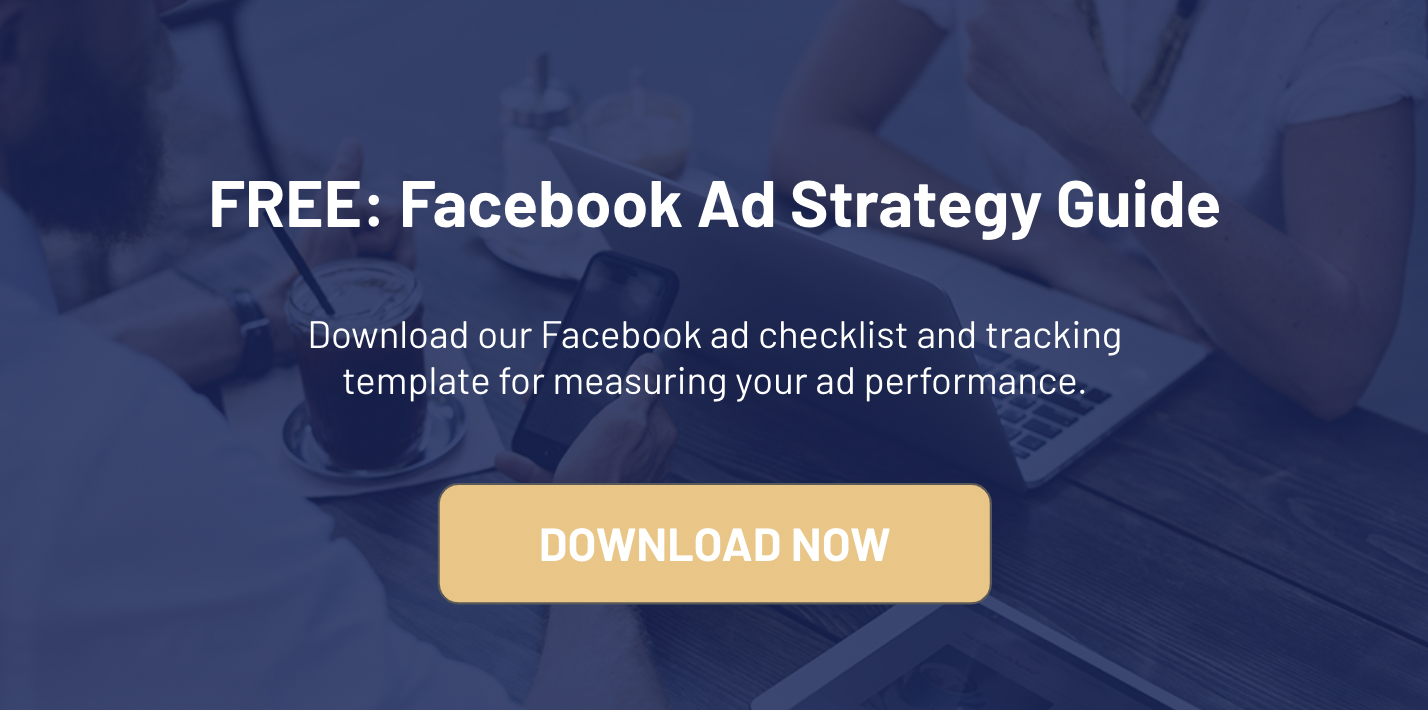Want to learn how to use Facebook advertising to generate consistent leads and sales for your online course or high-ticket programs? Check out this complete guide to creating a Facebook advertising strategy for your business, featuring insights from Thinkific customers and advertising experts that have collectively spent over $100 million on Facebook ads.
Generating consistent sales is a common challenge for all types of entrepreneurs, and online course creators are no exception. When it comes to selling online courses, even if you have a sizeable audience, there may come a time when you’ve exhausted your promotional efforts and your chances of acquiring new customers from your existing audience are slim. At that point, you need to reach new people to start generating sales.
For many successful online course creators, the solution to growing their audience and generating consistent sales is Facebook advertising. With more than a billion monthly active users and a very robust platform for advertisers, running ads on Facebook is an effective way to reach your target audience, and ultimately, start generating consistent leads and sales for your online courses.
Before creating this guide, we reached out to some of the top Facebook advertising experts in the world – people that have collectively spent well over 100 million dollars on Facebook ads – as well as several Thinkific customers who are using Facebook ads to promote and sell online courses.
Although the examples we’ll be referring to throughout this guide come directly from our community of online course creators, these same Facebook advertising strategies can be used to sell other types of offers as well – including coaching, consulting, live events, and done-for-you services.
What to expect from this guide
As you are probably already aware, Facebook advertising is a large (and continuously evolving) topic – one that thousands of digital marketers and ad managers devote full-time careers to. We’ve done our best to create a guide that will enable you to create a Facebook advertising strategy for your business, but to avoid going down the rabbit hole of technical steps, we’ve linked to specific tutorials on Facebook’s Help Center where appropriate.
The purpose of this guide is to help you create your Facebook advertising strategy. To execute your strategy, we recommend utilizing Facebook’s help center or hiring a Facebook ads manager, or both.
To get the most value from this guide, make sure you download our Facebook ad checklist and tracking template for measuring your ad performance. These free resources will help you to implement what you’re about to learn. Enjoy!
BEFORE YOU SPEND ANY MONEY ON FACEBOOK ADVERTISING…
Facebook is a very powerful platform. But it is also very robust and constantly changing. If you’re not tactful, you can easily spend a lot of money without getting a return on your investment.
So, before you rush into using Facebook advertising to try to sell online courses, please read the following warnings:
Warning #1
Facebook (or any advertising platform, for that matter) is not the place to “test” your offer.
Unless you’re literally prepared to lose money to try to find the winning match between your online course (your offer), the right message (your ad), and the right target audience (your ideal customers), you are not ready to spend money on advertising.
It’s best to think of Facebook advertising (and paid advertising in general) as fuel that you pour onto an existing fire to help that fire grow faster. If you’re counting on ads to start a fire, you will likely be setting yourself up for an expensive and frustrating learning curve.
Before you attempt to scale your online course business using Facebook ads, make sure you meet the following criteria:
- You know who your ideal customer is (your target market)
- You have proof of market demand (you’ve already sold a few courses)
- You have proof of concept (case studies or testimonials from other students who have taken your course and achieved their desired result)
- You know your customer acquisition cost (the amount of money you can spend to acquire a new customer profitably)
Warning #2
Facebook is a social media platform, not a marketplace. Unlike Amazon, people generally don’t log on to Facebook to shop for products with their credit card in hand. They log on to Facebook to socialize and interact with other people.
This means that running ads that essentially say “Hey! Buy my course!” to people that don’t know or trust you is a losing strategy. Facebook prioritizes user experience over advertising revenue. Showing a user an ad that isn’t relevant to them creates a bad experience for that user. If you run ads that people don’t like or engage with, you will essentially be punished with higher advertising costs.
An ad that says “Hey! Buy my course!” (okay, maybe not in those exact words – but with the same objective nonetheless) will do better as a retargeting ad that is specifically shown to people who already know you, and have been through your sales process but did not purchase. In this context, your ad is reminding them to purchase your online course. It’s nudging them to cross the finish line. It’s not the first thing they see from you or your brand. We’ll discuss retargeting ads in more detail later in this guide.
“When you approach Facebook with the intent to get something, rather than to give your audience something they will value, you will lose.”
– Nicholas Kusmich, Facebook Advertising Expert
Warning #3
The recommendations outlined in this guide are for informational purposes only. Without knowing your specific course topic or industry, course price, target audience, revenue goals, etc., we can’t possibly promise what kind of results you can expect from Facebook advertising. Think of our advice as your guideline. Ultimately, you’ll need to create your own campaigns and test different ads until you find what works for your business.
Remember, Facebook is a very robust platform that changes often. Depending on your budget and tolerance for “testing”, you may want to hire a professional to manage your Facebook advertising campaigns for you. If you do, make sure you set clear expectations in terms of budget and timeline before your ads become profitable.
The Buyer’s Journey and Your Sales Funnel
By themselves, Facebook ads do not replace a sales process. Facebook ads are best utilized to send prospective customers to and through an existing sales process. In other words, Facebook ads don’t replace the need for a sales funnel.
A sales funnel (also called a marketing funnel), refers to a sequence of steps that convert your target audience into paying customers. It is the process you use to attract prospective students for your online course and convince them to purchase it.
The most effective sales funnels mirror the Buyer’s Journey and address the psychological needs in each stage of the buying process.
The Buyer’s Journey:
The Buyer’s Journey refers to the sequence of steps that a buyer goes through leading up to making a purchase decision. This journey begins with the buyer becoming aware of a problem they want to solve (or a result they want to achieve), followed by considering various solutions that can help them, and lastly, choosing one specific solution and making a purchase.

Your Sales Funnel:
A sales funnel that mirrors the Buyer’s Journey, therefore, has escalating steps that guide a prospective buyer from the awareness stage to the decision stage.
At the top of the funnel, your objective is to generate awareness for your business by illuminating the problem your prospective customer is searching for a solution to.
In the middle of your funnel, your objective is to acquire a lead, moving them into the consideration stage of the Buyer’s Journey.
At the bottom of the funnel, your objective is to present them with your offer and ask them to make a purchase decision, moving them into the decision stage of the Buyer’s Journey.

Facebook campaigns, ad sets, and ads
Before we dive into what types of campaigns and ads to create, let’s go over some basic terminology.
A campaign is an umbrella under which multiple groups of ads that have the same objective will live.
An ad set is a group of ads that have the same goal.
An ad is what will be displayed to the specific users that you target. You will likely create multiple variations of an ad to test which version is most effective.
One campaign can have multiple target audiences, multiple ad sets, and multiple versions of ads, resulting in dozens (or even hundreds) of possible combinations of target audiences, ad sets, and ad variations.

As an example, you might create a campaign with the objective of promoting your blog posts. Inside of that campaign, you might create an ad set for each of the blog posts you are promoting. And within each ad set you might create multiple versions of an ad to see which one does the best job of getting people to click the link to your blog post.
“Only have one business objective per ad campaign. Don’t assume people will watch, like, and convert on the same ad. If you want more than one thing, create a new campaign for it.”
– Azriel Ratz, Ratz Pack Media
Campaign Type #1: Audience Building (Awareness)
Unless you already have an existing platform or audience (from a blog, podcast, YouTube channel, email list, social media following, etc.), the first type of campaign you should create is an audience building campaign.
An audience building campaign, as the term implies, is a campaign that is created specifically to build an audience of potential customers (aka prospects) for your business. There are billions of users on Facebook. The objective of your audience building campaign is to identify specific segments of those users that are most likely interested in your online course: your target audience.
The goal of an audience building campaign is not to generate leads or sales, it’s to generate awareness for your business. This is accomplished by running ads to your free content, such as blog posts, videos, podcast episodes, etc. We like to call these types of ads prospecting ads.
When someone clicks on your prospecting ad and consumes your free content (content that is relevant to your online course), they are identifying themselves as being interested in your course topic. Therefore, we can safely assume they are a member of your target audience. If someone isn’t interested in learning how to train their dog, they aren’t going to click on an ad for a blog post that shares your “Top 10 Dog Training Tips”.
As you increase traffic to your website by running ads to your free content, you build up an audience of people who have expressed interest in your course topic and who now, at least to some degree, know you and trust you. As this is happening, you’re building up an audience that you will target in other types of campaigns.
Note: Depending on the size of your existing audience, you might be able to skip ahead to creating the second type of campaign in this guide. Instead of running prospecting ads to identify and reach your target audience, you can run a list building campaign to your existing audience.
How to create a custom audience for audience building campaigns:
The key to creating a custom audience for prospecting purposes is to not get too specific. Facebook isn’t going to show your ad to every single person in a custom audience that you create. They’re going to show your ad to a smaller segment of that audience, in an effort to identify what type of person in that audience is most likely going to click on your ad.
Facebook’s algorithm works to match the right ad to the right person at the right time so that they click on the ad. It is looking for the best combination of these variables, one that provides a positive experience for its users and a profitable experience for its advertisers.
If you run a prospecting ad to a small audience, you basically give Facebook no other choice but to show your ad too many times to the same people, resulting in a negative experience for those users. By creating a custom audience that isn’t too narrow, you’re giving Facebook’s algorithm a larger pool to play in.
For prospecting ads, we recommend creating custom audiences with at least several hundred thousand people (a million people is even better) and letting the algorithm work its magic.
To give you an example, we tested a few prospecting audiences for a blog post about scaling a client business. We identified several influencers that coaches, consultants, and service providers follow on Facebook. We created a custom audience for each influencer, running the same ad to all three audiences simultaneously to see which one would perform the best.
We set a budget of $20 per day for each audience (all three of these audiences were approximately the same size), let the ads run for a few days and then looked at the data:

After spending a little over $400 on this test, our ads received 137,260 impressions and drove 1,382 clicks to our blog post. At a cost of $0.20 per click, one of those custom audiences drove nearly twice as many clicks as the others. Voila! We found a winner.
“Start with your top 10 industry/thought leaders who have a business like yours, with a larger, more engaged audience than you have, then try to use them to create a custom audience to target their audience in your ‘getting to know you’ ads.”
– Sherri-Lee Woycik, Social Media Minder
How to create a custom audience on Facebook:
There are two types of custom audiences you can create for your audience building campaigns. The first is an interest-based custom audience. The second is a lookalike audience.
Creating an interest-based custom audience
An interest-based custom audience is an audience that is made up of similar interests. At a minimum, you should also specify the age range and countries that you want your audience to be in (demographics), but the most important thing these people will all have in common is a person or company that they follow (their interest).
Here are the basic steps involved in creating an interest-based custom audience (for a more in-depth tutorial, check out Facebook’s instructions here):
- Log in to your Facebook Business Manager
- Click on Audience Insights
- Click on Create New, then select “Everyone on Facebook”
- In the left menu, start selecting specific criteria (countries, age, interests, etc.)
- When finished, click on Save
This process should only take you a few minutes. Here’s a quick video showing how I created an interest-based custom audience in less than 30 seconds:
Creating a lookalike audience
A lookalike audience is an audience that (according to Facebook) closely resembles a custom audience that you’ve already created, such as your leads or customer list.
As you can imagine, this type of audience becomes more effective as your other custom audiences grow in size (website visitors, leads, customers, etc.). To learn how to create a lookalike audience, follow these instructions here.
“Create a Lookalike Audience from a list of customers that already completed the ultimate goal that you essentially want others to complete as well. That’s how you’ll end up with a highly effective cold audience that’s ready to get what you offer.”
– Mojca Zove, Super Spicy Media
Naming your saved audiences
To help keep your ad account organized, we recommended establishing a naming structure for your saved audiences. As you create multiple audiences for prospecting purposes, having a consistent naming structure will make it easy for you to search for a specific audience that you’ve created, as well as understand at a quick glance who that audience is comprised of.
At a minimum, we recommend including the following elements in your naming structure:
- Audience Type
- Interests
- Countries
- Age Range
To give you an example, I recently created a prospecting audience of people who are fans of Tony Robbins, live in the United States and are between the ages of 25 and 50.
The “(P)” stands for Prospecting (my audience type). The rest is self-explanatory. It turns out there are 11,000,000 people that fit these criteria. Tony Robbins is a popular guy!

“Don’t create an ad campaign unless you have a specific objective in mind, and know how much you are willing to pay for that event to happen. You need to know why you are spending your money.”
– Azriel Ratz, Ratz Pack Media
Campaign Type #2: List Building (Leads)
The second type of Facebook campaign is a list building campaign. The goal is to generate leads for your business. In the context of selling online courses, a lead is defined as a prospective buyer of your online course who gives you their email address.
You’re welcome to skip creating an awareness campaign and jump straight into creating ads for a list building campaign, but you will likely end up spending more money to acquire a lead than you would if you target people that already know who you are (because they’ve seen your content and/or awareness ads before) than people who have never been exposed to you before.
With a list building campaign, you’re essentially running ads that “ask” people to willingly give you their email address in exchange for a free resource of some kind.
What you give away as a free resource in exchange for someone’s email address is up to you. We’ve seen online course creators (and entrepreneurs in general) give away all kinds of free training and resources to build their email lists, including:
- Short guides
- Checklists
- Worksheets
- Case studies
- Quizzes
- Webinars
- Mini-courses
- Email courses
Related: How to Build an Email List (Complete Guide)
“You need to map your retargeting campaigns to the stage of the relationship the audience you’re targeting is in.”
– Paul Ramondo, Facebook Advertising Expert
The type of free resource you create is not as important as who you create it for and how much it helps them. And you can (and should!) experiment with different free resources to see which ones are the most attractive to your target audience.
For some more ideas on what kind of free resource (aka lead magnet) to create for your audience, check out these 3 lead magnet ideas here.
Jonathan Levi from SuperLearner Academy, for example, built a 7-figure business selling his signature online course that teaches speed reading and memory skills. His primary method for building his email list was running ads to a free 1-hour webinar where he teaches people how to triple their reading speed.
Here’s a screenshot of one of Jonathan’s retargeting ads (this ad appeared in my newsfeed just a few minutes after I visited his website):
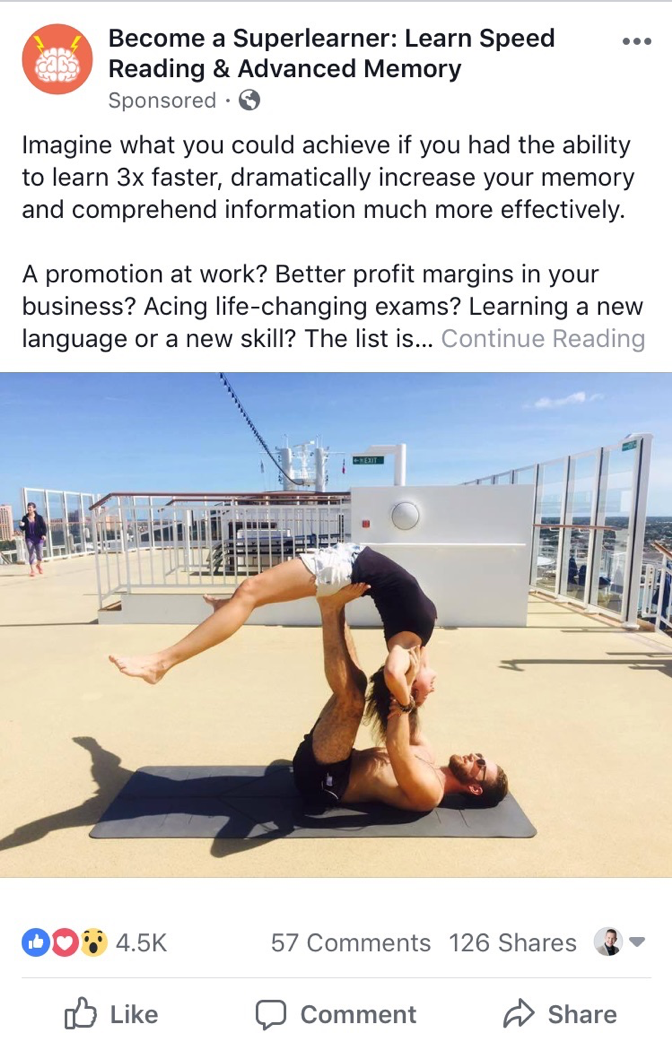
Side note: We published an in-depth case study on how Jonathan Levi built his business, including the exact sales funnel he used to scale his business to over $100,000 in online course sales per month. You can read the case study here.
Here’s another example of a Facebook ad used to promote a webinar. According to Billy Bross from Linchpin Media (the ad manager for this campaign), this ad is directly responsible for generating hundreds of leads and thousands of dollars in online course sales per month for Proofread Anywhere:
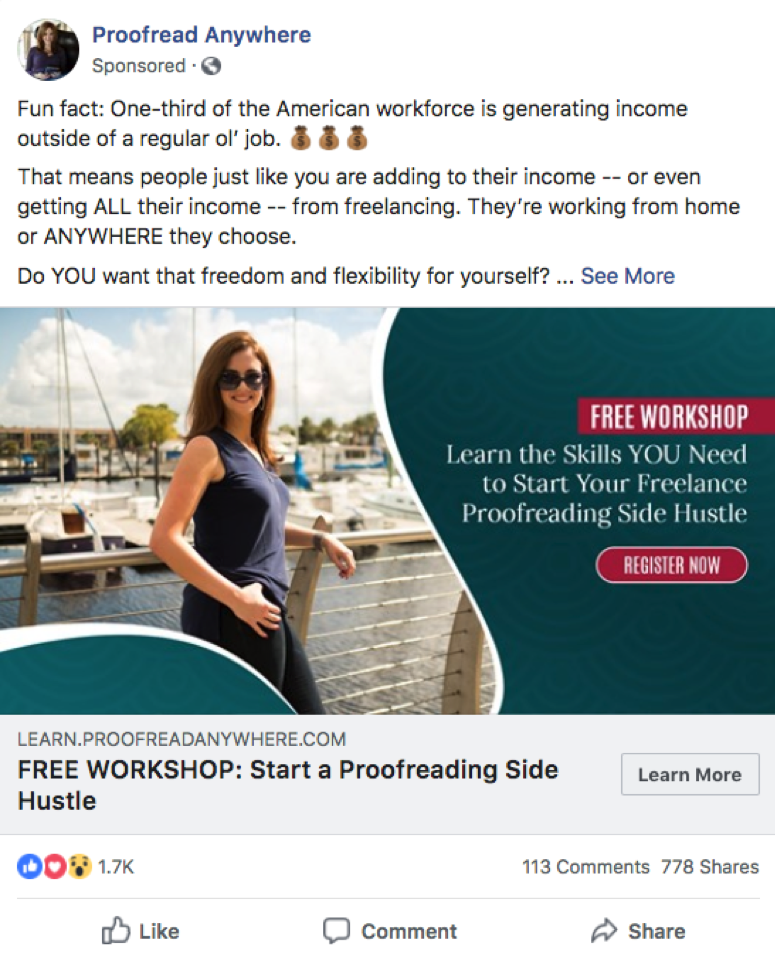
Related: How to Host Webinars To Sell Your Online Course (Complete Guide)
“Know where your retargeting audiences are in the value journey (sometimes referred to as customer journey). Be sure to retarget with campaigns and calls-to-action based on where they are in that journey. i.e. do not try to convert a sale on a website retargeting audience. Instead, nurture them with value and content to build likability, trust and goodwill. After people engage with your content is the best time to retarget for the conversion/sale.”
– John Dennis, VX3 Digital
How to create retargeting audiences to build your email list
Before you can create retargeting ads for a specific audience, you’ll need to set up your Facebook pixel. A Facebook pixel is code that you place on your website. It helps you track conversions from Facebook ads, optimize ads based on collected data, build targeted audiences for future ads, and remarket to people who have taken a specific action on your website.
How to set up your Facebook pixel:
To set up your Facebook Tracking pixel, log in to your Facebook Business Manager. Under the Events Manager, click on Pixels.

Once you’re there, follow these instructions to create your Facebook pixel.
Once you have your Facebook pixel, the next step is to add it to your website. If you’re not sure how to do this, follow these instructions, or contact your website or theme developer to ask for guidance.
If you’re using Thinkific to host your online courses, follow these instructions to add your Facebook pixel to your Thinkific website.
How to create a custom audience for retargeting:
Once you have your Facebook pixel set up, you can start creating custom audiences of people that have visited your website and/or specific pages on your website.
To create a retargeting audience, follow these steps:
- Log in to your Facebook Business Manager
- From the Assets column, select “Audiences”
- Click on “Create Audience”, then “Custom Audience”
- Select a source for your custom audience (ex. “Customer File” or “Website Traffic”)
- Select the criteria for your custom audience
- Name your custom audience, then click on “Save”
Here’s a screenshot of one of our own custom audiences, created for running retargeting ads to anyone who has visited Thinkific’s blog in the past 30 days:
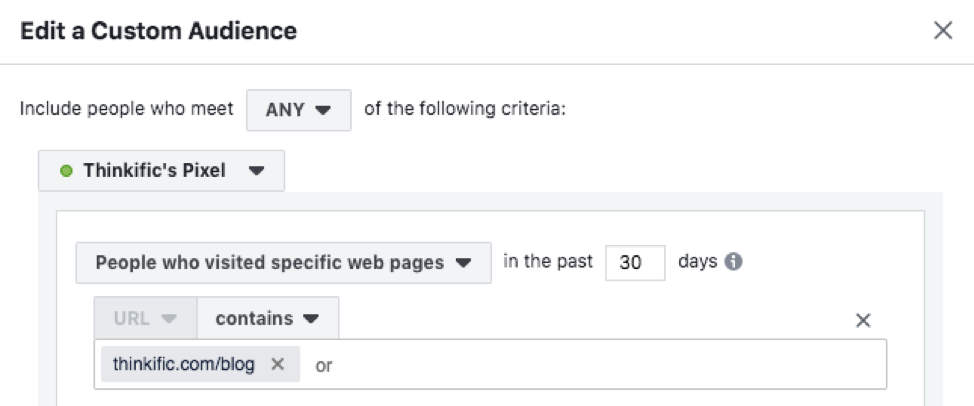
Just like with your prospecting audiences, I recommend using a naming structure so that you can easily identify your retargeting audiences.
At Thinkific, we use “(R)” to identify our retargeting audiences, “(V)” to identify website visitors, and “(L)” to identify leads.
Here’s the naming structure we used when we created a retargeting audience of people who have visited our blog in the past 30 days:

Since it would be redundant to have your existing leads or customers see your list building ads, you should also exclude those people from your retargeting audience. You can do this by identifying specific pages that only existing leads or customers would have visited, such as the confirmation page that someone lands on after they join your email list or make a purchase.
This process of creating retargeting audiences is what enables you to run ads specifically to people who have seen your content but are not yet leads, or are leads but are not yet customers, or are customers but haven’t purchased your upsell, and so on. As a result, any ad that someone in one of your custom audience sees should be an ad that is specifically meant to move them further along in your sales funnel.
“Have a clear funnel from cold to hot. Ensure that your second and third remarketing message plays off the first initial cold traffic content. Continue to reiterate all possible pain points/benefits that customers may question.”
– Nick Shackelford, Common Thread Collective
Campaign Type #3: Customer Acquisition (Sales)
The third type of Facebook campaign is a customer acquisition campaign. If you’re selling online courses, these are the ads that will help you to convert leads into paying customers and start generating a profit from all of your marketing and advertising efforts.
From what we’ve seen from Thinkific’s most successful customers that are using Facebook ads to sell their online courses, they aren’t actually relying only on their ads to sell their courses. They have automated sales funnels in place that sell their courses, and they utilize ads to help pick up the slack.
Some of our customers use automated email campaigns to convert their leads into customers. Some host webinars. Some offer free courses, which upsell their paid courses.
When a prospective buyer goes through their sales funnel without purchasing their course, this triggers a retargeting ad that “nudges them” to complete the checkout process.
Types of retargeting ads for customer acquisition:
- Free trials
- Customer testimonials
- Enrollment open
- Enrollment closing
- One-time discount
- Exclusive bonuses
Foundr Magazine, for example, recently launched an online course about email marketing. I joined the waitlist a few weeks prior to their launch (they built an email list of prospective buyers before they launched their course – a strategy that we highly recommend).
Once their course was launched, I received an email to let me know that enrollment was now open. I visited the sales page for their course, but I didn’t purchase it. Shortly after, I started seeing one of their retargeting ads for the course:

This is an example of creating an ad to “nudge” people to purchase a course that they’ve already been through the sales process for. These types of ads can be very effective because they’re targeting people that have already been through a sales funnel – the low hanging fruit.
Here’s another example of a retargeting ad for customer acquisition (see screenshot below). This one appeared in my newsfeed shortly after visiting the sales page for Jonathan Levi’s course. It’s a video ad, acknowledging that I left the sale page without purchasing, and asking me if I have any questions or need additional information before making a decision. Nicely done Jonathan!
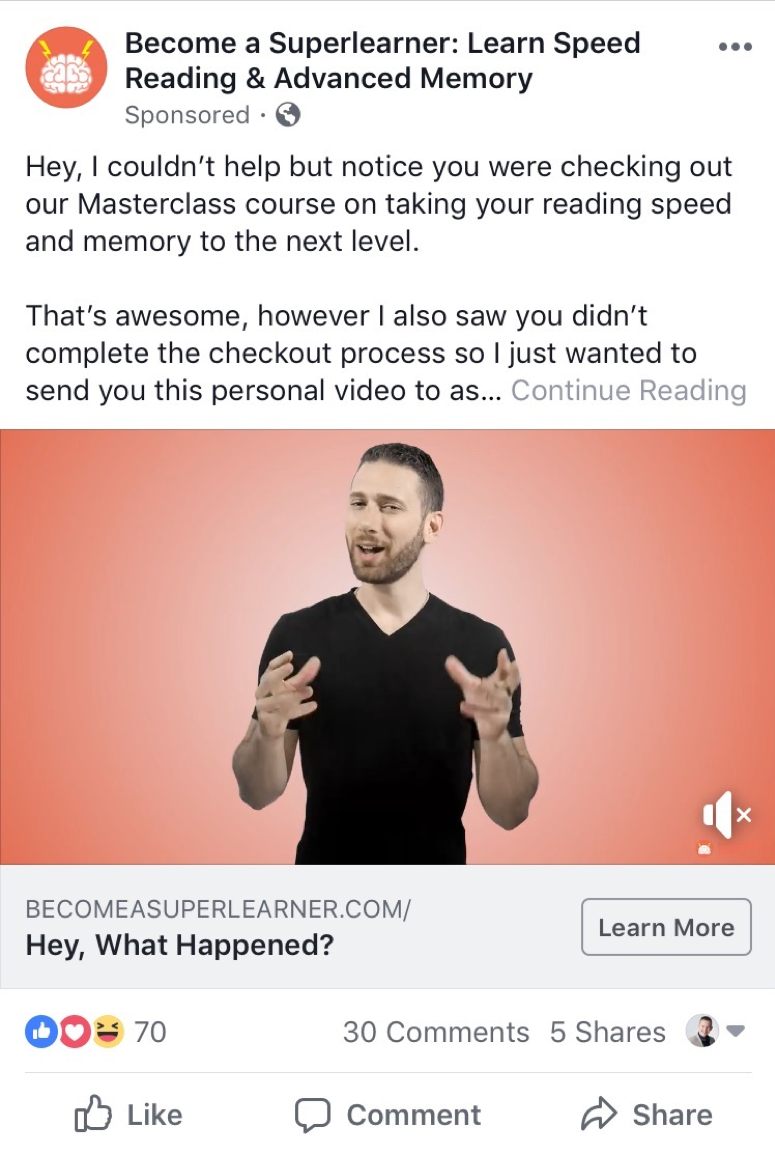
“The more times someone sees your ad, the more likely that person is to buy from you. And that’s the beauty of retargeting. You are showing ads to people who – you know for a fact – have already shown interest in what you are selling.”
– Justin Brooke, AdSkills
How to create a Facebook campaign
Okay, now that we’ve gone over the different types of campaigns that you will create ads for, it’s time to show you how to actually create a campaign. Creating a Facebook campaign is the first step to creating an ad, because an ad needs to live inside of a specific campaign.
To create a new campaign, start by logging into your Business Manager (not your personal account). If you don’t have yet have a Business Manager account, you can learn how to create one here.
Once you’re logged in to your Business Manager, click on your Ads Manager from the top left menu. Then, follow these steps:
- Click on the green Create button.
- Set a goal for your campaign (traffic, video views, lead generation, conversion, etc.).
- Name your campaign (ex. “Blog Post Promotion”)
- Name your ad set (ex. “Top 10 Dog Training Tips”)
- Choose where to send traffic (ex. “website”)
- Select your target audience (use a saved audience, or create a new one)
- Select your placements (Facebook recommends using Automatic Placements)
- Choose your budget, schedule, and optimization preferences (ex. $5 per day for 30 days, optimized for link clinks)
This list of steps isn’t meant to be comprehensive. Some of the steps listed above have multiple options and sub-steps in them. For more in-depth instructions on how to create a new campaign, check out Facebook tutorials for advertisers here.
Once your campaign is created, you can create your first ad. We’ll go over the main elements of a Facebook ad next. To learn how to create an ad, follow these steps here.
5 main elements of a Facebook ad:
A Facebook ad is made up of 5 main elements. Technically, not all of these elements are necessary (the newsfeed description, for example, is an optional element), but unless you have a very specific reason not to use one of them, we recommend using all of them.
- The image
The most important element of a Facebook ad is the image. Yes, the other elements are important, but unless someone stops scrolling and actually reads the ad, those elements don’t matter. Therefore, the purpose of the image is to get someone to stop scrolling and actually read the ad. The same concept applies to videos, carousels, slideshows, and collections.
- The headline
The headline text is the largest text in an ad and will appear in bold. Use the headline to describe what your ad is for. Are you promoting a blog post? Are you giving away a free resource of some kind? Describe it clearly in your headline.
- The body
The body of your ad is where the majority of your copy will live. If you write enough copy for this section, viewers of your ad will need to click on “Continue reading” to see the rest of it. Long-form ads mimic Facebook posts that people often share from their personal profiles, which is part of the reason why they are so effective (they don’t look like ads).
- The description
Utilize this section of the ad to include some short, persuasive copy that helps to convince someone to take the action you want them to take. Your description will appear in smaller text below the headline of your ad.
- The call to action (CTA) button
The call to action (CTA) button is the button that you want your audience to click on. Our favorite buttons are “Learn more” and “Sign up now”, depending on the goal of our ad. If your goal is simply engagement (such as video views, for example) you may not need to use a CTA button.
An example of an effective Facebook ad
Here’s an example of a Facebook ad used by our customer Lewis Howes, promoting one of his free webinars:
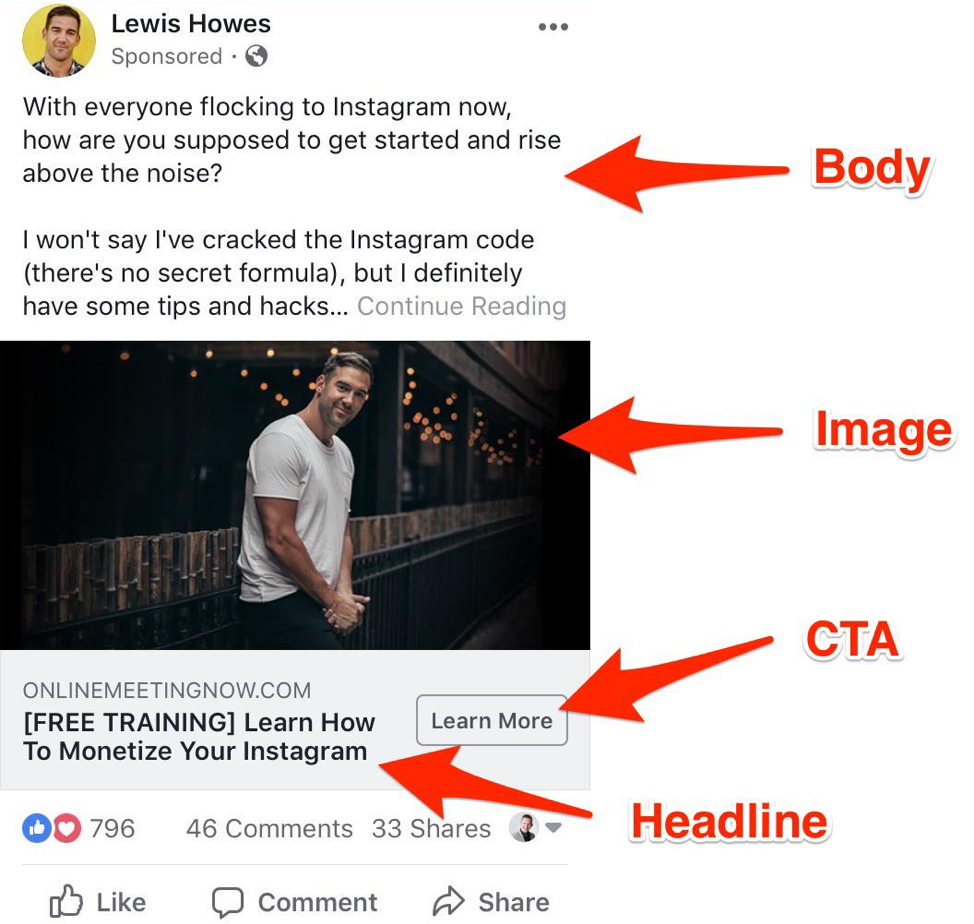
“Don’t assume that what worked in the past will work again. Approach Facebook ads with a wholehearted “test anything” attitude. The platform, its audience, and algorithm are constantly changing. Constantly think of new options, asks, and angles… and TEST them!”
– Dan Gardeen, Adnomadic
Split testing your Facebook ads:
Even when you follow the best practices for creating a Facebook ad, not all of your ads will be successful. In fact, most digital marketers, regardless of the platform they run their ads on, will tell you that most ads fail.
What determines whether or not an ad is successful is not how clever, creative or attractive it is. A successful ad is one that accomplishes its objective at a cost that is less than or equal to what you are willing to spend to accomplish that objective.
For example, if you’re able to spend $10 to acquire a lead (profitably) and one of your ads is bringing in leads for $12 each, then that ad is a failure.
A successful ad is one that accomplishes its objective at a cost that is less than or equal to what you are willing to spend to accomplish that objective. #FacebookAds #FacebookAdvertising Click To TweetAs marketers, we do our best to create ads that we think will do well, and then we verify our assumptions with real data. We’re often humbled by the results, and that is just part of the process. Even a winning ad won’t stay a winner forever. We must continually create, test, kill and/or scale up our ads.
With that in mind, when it comes to testing your ads, there is a golden rule that you must obey: only test one variable at a time.
If you test more than one variable at a time, you can’t know for sure which change in a variable caused a change in the results. We recommend keeping a log of all your split tests so that you (and others on your team) can see what has been tested, what has worked, and what hasn’t worked.
These are the main variables of an ad that you can (and should!) test:
- The audience
- The image
- The headline
- The description
- The body
- The call to action (CTA)
Depending on your budget, it might not be feasible to test all of these variables at once while simultaneously gathering enough data to justify the tests in the first place.
For your audience building campaigns, a good starting point is to split test a small handful of prospecting audiences at a time, along with 2-4 different images per ad.
Life and business strategist Shazzie, for example, was able to turn a failing ad into a huge success simply by testing a different image. The image on the left (see below) was getting almost no engagement. The image on the right received hundreds of likes, dozens of comments and shares, and produced over $88,000 in online course sales over a 12 month period. She spent $12,000 on this campaign, resulting in more than a 700% ROI, all thanks to split testing. Not bad!
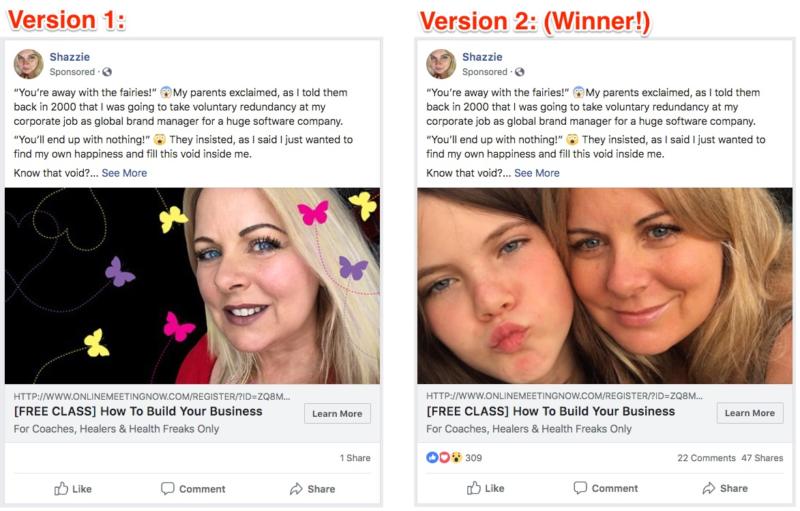
For your list building and customer acquisition campaigns, you generally don’t need to split test your target audience, since these types of campaigns are created for a specific retargeting audience already. Instead, test different elements of your ads: the image, headline, description, body, or CTA.
“People who do not split test are leaving lots of money and opportunity on the table. Split testing doesn’t have to be complicated – even one can make the difference between success and failure.”
– John Dennis, VX3 Digital
Tracking your Facebook ads (important metrics)
When it comes to using Facebook ads to promote your online courses, it is absolutely critical that you track everything. What gets measured gets improved.
Here are some of the most common metrics worth tracking:
- Impressions: the number of times your ad is seen
- Reach: the number of people that see your ad
- Click Through Rate (CTR): the percentage of people who see your ad and click on it
- Cost-Per-Click (CPC): the amount you pay when someone clicks on your ad
- Cost-Per-Lead (CPL): the amount you pay to acquire a lead
- Cost-Per-Acquisition (CPA): the amount you pay to acquire a customer
- Return On Investment (ROI): the amount of revenue generated from your ads divided by your total ad spend
Funnily enough, the subject of metrics is one that marketers debate quite often. Yes, there are several metrics worth tracking as you run Facebook ads. But without seeing the whole picture, some of these metrics can be misleading.
To help avoid confusion, remember this:
The most important metric to track is ROI (Return on Investment).
In other words, don’t freak out and turn off your ads just because your CPC or CPL costs are increasing. If the ROI of a specific campaign or ad is acceptable to you, does it really matter what your CPC or CPL is?
Just because an ad is getting a low CPC or CPL doesn’t mean that it’s a profitable ad. If the people clicking on your ad or subscribing to your email list don’t convert into customers, you’re going to lose money. Losing money is not sustainable.
This is why tracking your data all the way through to acquiring a customer is so important. Don’t judge the success of an ad by looking at any one metric in isolation. You need to see the whole picture. The whole picture is the ROI of your advertising efforts.
To track the ROI of your Facebook advertising campaigns, download our Facebook Ad Tracking Sheet:
“In a normal ad campaign you set a max bid and a daily or lifetime budget. Then an auction happens between you and every other advertiser vying for the same audience. The winner is whoever has the best combination of click through rate (CTR), relevance, and cost per click (CPC) bid.”
– Justin Brooke, AdSkills
Start small, find what works, then scale up
Congratulations! You are officially armed with more knowledge about using Facebook ads to sell online courses (or other high-ticket products and services) than a significant amount of people who are already running ads and learning via trial and error.
In other words, you know just enough to be dangerous. And for that reason, we recommend starting slow and scaling up as you figure out what works.
“Never start with a huge daily budget. Start with a low daily budget so you can split test to see what’s working. Once your ad sets and ads EXIT the learning phase you can optimize for the best performers and scale your budget accordingly.”
– Paul Ramondo, Facebook Advertising Expert
If you’re jumping into Facebook ads for the first time, we suggest allocating a specific amount of money towards testing your first round of ads and gathering data – money that you are okay with “losing” in exchange for gathering that data. When it comes to paid advertising, emotions can get you into trouble. Learn to be indifferent and data-driven.
If your priority is building your audience, we recommend spending the majority of your advertising budget on your audience building campaigns. Once you’ve built up your retargeting audiences, then you can start to allocate more of your budget to your list building and customer acquisition campaigns. Many of our most customers run successful retargeting campaigns on budgets as little as $5 per day.
“The biggest mistake to avoid when using Facebook ads is to expect it to work the minute you turn the ad on. The second biggest mistake to avoid is to think Facebook ads are set it and forget it.”
– Nick Shackelford, Common Thread Collective
A final reminder about Facebook advertising
I mentioned this at the beginning of this guide, but I’ll mention it one last time because of how important it is: not every business is in a position to run Facebook ads.
Whether you sell online courses, coaching, consulting, done-for-you services, or some other product or service, it’s important to recognize what stage of business you’re in.
If you’re in the early stages of growing your business, relying on Facebook advertising to acquire customers might not be a wise strategy. Facebook advertising (and paid advertising in general) is best thought of as fuel for an existing fire. It’s not for starting a fire.
Before you start running Facebook ads to build your audience and promote your online course, make sure that you:
- Know who your ideal customer is (your target market)
- Have proof of market demand (sales/revenue)
- Have proof of concept (case studies or testimonials from other customers)
When your business fits all of these criteria, the risk of losing money from paid advertising is significantly reduced because you’re not spending money to figure out if your target market is willing to buy your course. You’ve already proven that with previous sales. Instead, you’re trying to figure out which combination of ads and targeting will help you to reach and acquire more customers. It’s a slight distinction, and a crucial one.
“Facebook ads are the delivery mechanism, not the purpose. I don’t wake up every morning excited about Facebook ads. I wake up excited to know that I have a chance to transform people’s lives. Facebook ads are the most powerful medium I’ve found in which to do that.”
– Nicholas Kusmich, Facebook Advertising Expert
Thanks for reading this guide all the way to the end, and best of luck with your Facebook advertising!
If you haven’t already, make sure you download our Facebook ad template and tracking sheets.
Are you using Facebook ads to sell your online courses? Share your experience with us in the comment section below!

